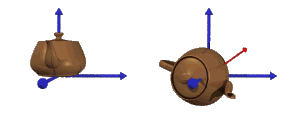Rotations in three-dimensions are considerably more complicated than two-dimensional
rotations. In general, rotations are specified by a rotation axis and an angle. In two-dimensions
there is only one choice of a rotation axis that leaves points in the plane.

There are several different ways to present rotations. I will use a different
approach than that used in most books. Typically, all possible rotations are treated as
the compostion of three canonical rotations, one about the x-axis, one about the y-axis
and one about the z-axis. In order to use this model you need to do the following.
Memorize the three canonical rotations, which aside from the signs of the sines, isn't
too hard. Next you have to go through a series of rotations which move the desired
rotation axis onto one of your canonical rotations, and then you have to rotate it
back without introducing any extraneous twists. This is a difficult and error-prone
process. But worst of all it is ambiguous. There exist several different combinations of
canonical rotations that result in the same overall result.
